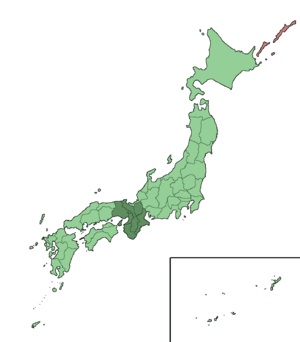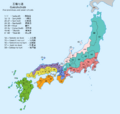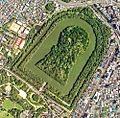Kansai region facts for kids
The Kansai region (also called Kansai-chihō) is one of Japan's traditional areas. It's also known as the Kinki region (Kinki-chihō). Japan is divided into eight main regions. These regions have been used since 1905 to describe and compare different parts of the country. They also help show cultural differences.
The regions of Japan combine old historical divisions with modern needs. The Kansai region is important for its geography, culture, and how it is managed.
History of Kansai
In the late 600s, the Kinki region was recognized as one of the eight largest administrative areas in Japan's old Imperial system. This system was called ritsuryo seido.
The Gokishichidō is an ancient system of names for parts of the country. It included the area known as Kinki or Kansai. Kansai covers the area around the old capital city of Kyoto. This city is on the island of Honshū. This area is roughly the same as the traditional Kinki region.
During the Meiji period (1868-1912), Japan created its modern regional system. Japan was divided into regions called chihō, and the Kinki region was one of them. A special council for each region helped manage things. The governor of the most powerful prefecture in the region led this council.
Over time, Kansai has developed its own unique ways of speaking (dialects). It also has special customs and a rich traditional culture that makes it stand out.
Related pages
Places named with Kansai
- Kansai Airport Station
- Kansai International Airport
- Kansai Ki-in (An organization for the game Go)
Images for kids
-
The Akashi Kaikyō Bridge, the longest suspension bridge in the world.
-
Himeji Castle, a famous Japanese castle.
-
Map showing World Heritage Sites in the Kansai region.
-
Daisen Kofun, the world's largest burial mound.
-
Hōryū-ji Golden Hall, the oldest wooden structure in the world.
-
Izumo no Okuni, who started Kabuki theater in Kyoto.
-
Kongō Gumi, once the world's oldest continuously operating company, built many of Japan's cultural treasures.
-
Sen no Rikyū, a merchant from Sakai, who perfected the tea ceremony.
-
Nintendo became a very successful video game company.
-
A view of Kyoto from Kiyomizudera temple.
See also
 In Spanish: Región de Kansai para niños
In Spanish: Región de Kansai para niños





















